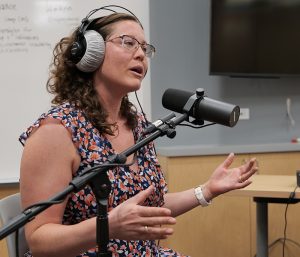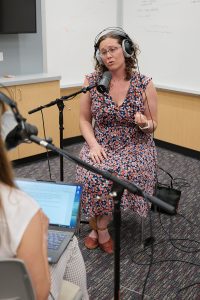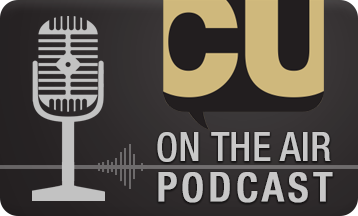Podcast: Play in new window | Download
Subscribe: Spotify | Email | RSS | More

Already in the U.S. in 2021, some 95 large fires have burned more than 2 million acres in 15 states. Nearly 24,000 wildland firefighters and support personnel are on the front lines across the country. Today on CU on the Air, host Emily Davies talks with CU Boulder’s Natasha Stavros, data and fire scientist and director of the Earth Lab Analytics Hub, about the effects of centuries of land mismanagement, technology in fire mitigation, and what we can do to save the Earth and even our lives.
- How did we get here? Since the industrial age, there has been in increase in the emission of fossil fuels. Fossil fuels trap the heat as if wearing a blanket. And the longer you wear that blanket, the warmer it gets.
- Fuel-limited areas, such as Nevada, don’t burn because there isn’t much growth. When areas, such as California, that have been historically lush suffer drought the fire problem becomes extreme.
- Smoke can travel across continents across oceans. Last September, satellite data showed smoke plumes all the way to the East Coast, over the Atlantic into Europe.
- Those who are sensitive to poor air quality can try out the EPA Air Now app or the Web MD allergy app.
- Hardening your home against poor air quality: Start with an air purifier. Also, increase the airflow and build wisely.
 Inequitable impact – often, poorer areas live downwind of the smoke and these areas can’t afford to upgrade to air purifiers and other air-quality components.
Inequitable impact – often, poorer areas live downwind of the smoke and these areas can’t afford to upgrade to air purifiers and other air-quality components.- The history of fire in America: Since Britain had few fires, the colonizers were frightened of fires and started practicing fire suppression. This led to centuries of fuel accumulation.
- Tribal Nations already knew the value of fires and the hazards of suppression, but it took until the 1950s for the U.S. to understand the perils of fuel build-up.
- How the Yellowstone fires re-kindled the fear of wildfires.
- Air quality standards – great! Except it conflicts with prescribed fires. The importance of finding a balance between these standards and creating a sustainable ecosystem.
- Technology is an immeasurable help in forecasting fire probability, measuring fires through satellites, drones and aircraft; learning how to reach specific groups to warn of fire dangers.
- The harrowing story that fueled Stavros’ desire to understand and collect data for fire; and how she came to CU Boulder.
- Wisdom, Know, Information and Data (WiKID) was developed by Stavros while she was at NASA – solving wicked problems through innovation as a process, not a product.
- The best computer is still the human brain – informed actions are wisdom. Using the brain and technology can inform human behavior to envision, act on and ensure a healthier future.
- The Earth Lab Analytics Hub at CU Boulder is a collection of big data, environment change and great minds. And it’s a women-led team!
- Fire zoning isn’t a thing yet, but it should be just as much as hurricane and flooding. People need to build responsibly.
- Stavros and colleagues recently brought together top fire technology innovators with fire managers, politicians and academics to brainstorm solutions to wildfire problems.
- Eliminating competing ‘asks’ with best minds and pooled funding from across the country makes headway on the fire mitigation.
- Solutions will require sustained access to observations, such as cameras, satellites, Twitter. Getting open access to data is imperative for cross-thinking.
- Understanding the ongoing cost and how to sustain management and make progress in creating a healthy ecosystem.
- It’s time to think about our roads and how to upgrade that infrastructure because this affects evacuation routes going in and out of places and congestion.
- The need to shift away from the framing of suppression to resilience and what that entails.
- Micro-grids include using the local ecoystems – such as wind or water – to create and sustain clean energy, thus not transporting energy through volatile grids across long distances.
- Prevention and a healthy climate: Talk to your friends and neighbors about the importance of fire and resilience; the importance of hardening their homes against poor air quality.
- If there is a fire and you’re warned to evacuate, do it. Do it now!
- Be prepared: Know your escape route and what you’ll gather in five minutes to take with you.
- What we experienced in 2020 is not the future, it is today and it’s going to keep happening. Luck only happens so often.
TEXT TRANSCRIPT
Resources
- Wisdom, Know, Information and Data (WKID)
- Earth Lab Analytics Hub
- NASA Fire Research
- CU Boulder
- Interpreting uncertainty when making decisions, TEDx Claremont Colleges
